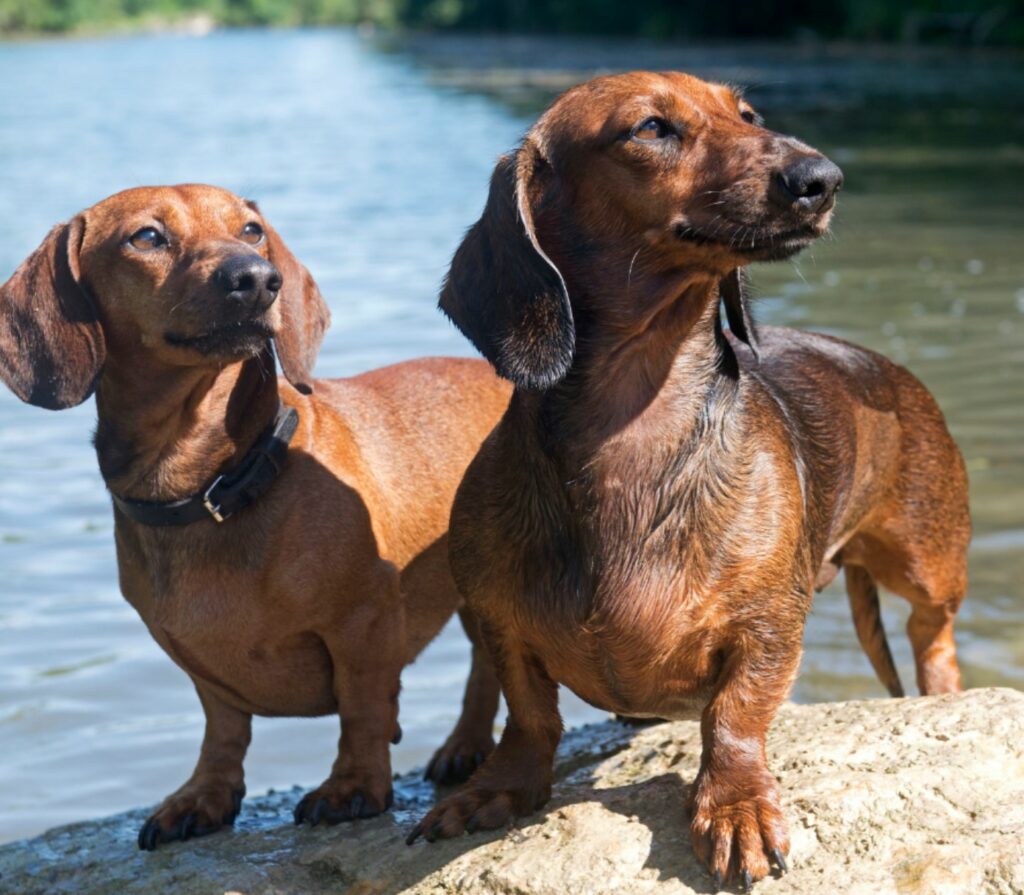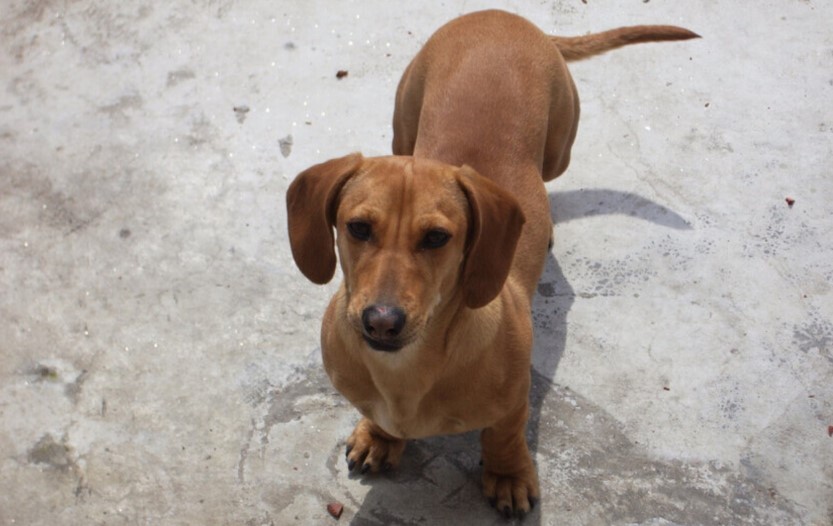Compared to us humans, animals become self-sufficient very soon after birth. Antelopes, for instance, can walk only a few minutes after they are born.
Puppies fall somewhere between these two extremes: they start out completely helpless, then gradually develop into the dogs they are meant to be. When do dachshunds reach full size and become less dependent on their owner’s care?
How Can You Tell Whether Your Dachshund has Become an Adult?
A mature dachshund measures about 8 to 9 inches (20 to 23 cm) from floor to shoulder, 21 to 25 inches (55 to 64 cm) from its nose to the base of its tail, and weighs between 16 and 32 pounds (7¼ to 14½ kg).
Of course, these numbers are only average for non-obese dogs. If you’re worried about how big your pup will grow, it’s a good idea to take a look at its parents and siblings from previous litters for an estimate.
Dachshund puppies have large paws relative to their legs and body. They’re also soft and squishy all over instead of having visible muscles around the neck, shoulders, and hips. If you’ve recently taken in a stray, these are signs that it hasn’t reached its full size yet.
On the other hand, a lack of muscle definition could also just mean that your dog is overweight. This is probably the case if you can’t clearly make out the structure of its hips and shoulders from above or feel its ribs with your fingertips.
When do Dachshunds Reach Full Size?
Like human babies, dachshund puppies have growth plates in their skeletons, especially the legs, that close as they grow older. This process typically completes by about 8 to 12 months of age.

Their leg joints are also still developing up to this point. Walking or feeding puppies too much can lead to problems later.
They can grow a little larger after this point, but their juvenile growth spurt will have ended for the most part. They will continue to bulk up and gain a little more weight until they’re eighteen months old or their second birthday, but this only matters if you insist on their doggy sweaters fitting perfectly.
You may find that your dachshund still looks like an oversized puppy for the next few years, though. A soft pelt, chubby face, and narrow ribcage are features that persist for several years even though a dachshund isn’t getting any larger.
What About a Dachshund’s Specific Breed?
Broadly speaking, all normal-sized dachshunds, from wire-haired to smooth varieties, grow and mature at roughly the same rate and are about the same size when mature.
There are some characteristic differences between varieties, but these sort of wash out due to the diversity found in individual dogs.
There’s also no real difference in the sizes of males and females as adult dogs or their growth rate.
At What Age Do Miniature Dachshunds Become Fully Mature?
One of the greatest advantages to having a dachshund as a pet is their affectionate nature.
Mini dachshunds really put the “lap” in “lapdog,” though. They end up about 4 to 6 inches (10 to 15 cm) tall at the shoulder, 10 to 16 inches (25 to 41 cm) long, and a petite 11 pounds (5 kg) in weight.
As with the full-sized kind, this bulk is reached when they’re between 8 and 12 months old.
What Kind of Behavior to Expect as Your Dachshund Reaches Full Size
Dachshunds are adorable beyond question; this makes it easy to forget that they’re really hunting dogs. The temperament and instincts needed for this job don’t arrive all at once but are developed over time.
Like their owners, they also go through various stages during their lives: puppy, adolescent, adult, and finally senior. Their personality continues to evolve and change as they grow older.
Let’s talk specifically about what happens around the time when they become adults. Up until about halfway to their first birthday, dachshund puppies are highly dependent on their mother and/or humans.
They sleep quite a lot (even compared to adult dachshunds), need plenty of physical contacts, and prefer familiar surroundings.
Around six months of age, as if a switch has been flipped, they become adolescents. This change is accompanied by hormonal shifts. Unlike with human teenagers who reach “that age,” this doesn’t manifest itself in screaming and slamming doors.
It can still be a strain on their owners, though.
They’ll suddenly become way more independent and curious, exploring every crevice of the home and garden and quite possibly getting into a few scrapes. They will handle boredom very badly and need all the attention you can give.
During this time, their stubbornness (and, occasionally, aggression) will also start to surface. The difference between a calm, obedient dachshund and a lifelong anarchist sausage is often how well they’re trained at between 6 and 12 months.
Luckily, they’ve mostly burned off their adolescent energy, learned appropriate behavior, and settled into a routine by the time their first birthday comes around. They will retain at least a little of their puppy-like enthusiasm for the next few years, though – don’t get a dachshund if you can’t keep it stimulated!
Dealing with Behavioral Problems in Adolescent Dachshunds
It’s entirely normal for your puppy to get a little mischievous between the ages of 6 and 12 months. This is the time when they’re testing their boundaries and figuring out their role in the family hierarchy, after all.
Consistently annoying behavior should be dealt with before it becomes habitual, though. Here are some common problems you might have with your dachshund puppy, as well as a few suggestions for resolving them:
Separation Anxiety
If your dog acts out, perhaps destroying household objects when you’re away. This is due to not knowing whether you’re coming back.
Solutions:
Don’t telegraph the fact that you’re leaving. Don’t give your dog goodbye pets or make getting your keys and wallet a ritual, sneak out instead.
Walking your dog in the morning will help it keep calm during the day. Toys that keep your dog occupied, especially canine puzzles, can distract it from being alone.
Excessive Barking
This is generally the result of an anxious and/or bored dog.
Solutions:
Exercise and stimulating toys can help with this, too. In addition, give your dog plenty of attention throughout the day, but not when it is barking unnecessarily. Doing so will reinforce the idea that barking = cuddles and make the problem worse.
Chewing
When no shoe or chair leg is safe.
Solutions:
Dogs get to know their environment not just with their eyes, ears, and nose, but their mouths as well. Supplying them with different toys and bones is usually enough to get them to stop. Anti-chew sprays may also help.
What to Feed Your Growing Dachshund
Buying the cheapest kind of dog food you can find is rarely a good idea. It doesn’t even save you money: poor nutrition can easily end up costing you more in eventual vet bills.
Speaking of which, that same veterinarian will be happy to recommend a good brand of kibble.
Dachshund puppies of up to about six months only recognize one portion size: as much food as they can possibly swallow. Lenient owners may well overfeed them by accident. The following chart can help you stay on track (the blue line is for mini dachshunds, the red for other types):

A slightly chubby puppy isn’t that much of a problem, but you’ll have to watch your furry friend’s weight as they approach adulthood. Food for mature dogs typically contains less fat and protein, along with a balanced mix of vitamins and minerals.
Pay attention to how much you feed them, take it easy with the treats, and consult your vet if your sausage continues to look more like a balloon.
When to Spay Or Neuter a Growing Dachshund
The thought of a new litter of cuddly puppies may set your heart a-pulsing. We need to be responsible about this, though: there are already too many abandoned, unhappy dogs waiting out their days in shelters.
We should mostly leave the task of bringing up new purebred dogs to registered breeders, anyway. At the very least, doing so strikes a blow against puppy mills.
Neutering or spaying a dachshund, a breed that’s known for stubbornness and getting their own way, also prevents many behavioral problems.
To prevent your dachshund from coming home with a little surprise (or leaving one for your neighbors to discover), it’s recommended that you get out the metaphorical scissors as soon as prudent instead of rolling the dice.
Dachshunds of either gender can reach sexual maturity at any point between 6 to 12 months. Depending on the vet’s professional opinion, you should take them for the operation as soon as males start to hump people’s legs or females start showing signs of coming into heat.
Don’t jump the gun, either, though.
Contrary to what many people still think, recent research indicates that spaying or neutering a puppy that’s too young can lead to several health problems your pooch really doesn’t deserve.
Final Thoughts
“When do dachshunds reach full size?” is only one of the questions a new owner will be asking themselves. What and how much they should eat, what their living and sleeping arrangements should look like, and how much they should exercise. All of these points have to be considered as they grow older.
Very often, even with the best advice, the internet has to offer, you’ll be flying by the seat of your pants. Each individual dog is just too different to generalize too much on any issue.
Fortunately, responsible dog owners have a personalized resource at their disposal in the form of their veterinarian.
Most puppies will go through three or four checkups before their first birthday, along with the necessary shots, dewormings, and other medications. If you have any concerns, ask: there are no stupid questions when your dachshund’s welfare is at stake.

